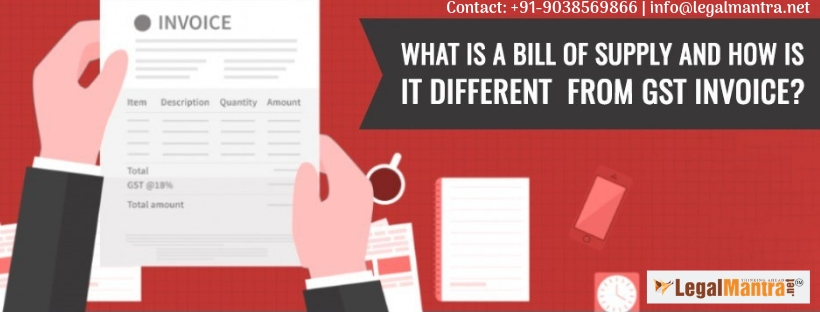View News
Difference between Tax Invoice and Bill of Supply

- Tax Invoice
Generally speaking, an invoice is a commercial instrument issued by a seller to a buyer. It identifies both the trading parties and lists, describes, and quantifies the items sold, shows the date of shipment and mode of transport, prices and discounts, if any, and delivery and payment terms. In certain cases, an invoice serves as a demand for payment and becomes a document of title when paid in full.
- Tax Invoice under GST
Under the GST regime, an “invoice” or “tax invoice” means the tax invoice referred to in section 31 of the CGST Act, 2017. This section mandates issuance of invoice for every supply of goods or services.
The invoice should contain description, quantity and value & such other prescribed particulars and the description and value & such other prescribed particulars (in case of supply of services). An invoice need not be issued if the value of the supply is less than Rs. 200/- subject to specified conditions.
- Mandatory Fields of a GST Invoice
A tax invoice is generally issued to charge the tax and pass on the input tax credit. A GST Invoice must have the following mandatory fields:
- Invoice number and date
- Customer name
- Shipping and billing address
- Customer and taxpayer’s GSTIN
- Place of supply
- HSN code/ SAC code
- Item details i.e. description, quantity (number), unit (meter, kg etc.), total value
- Taxable value and discounts
- Rate and amount of taxes i.e. CGST/ SGST/ IGST
- Whether GST is payable on reverse charge basis
- Signature of the supplier
- Bill of Supply
A business registered under GST issues a tax invoice to the buyer. Such an invoice mentions the GST rate charged on the goods and services sold.
However, some businesses even though registered under GST cannot charge any tax on the invoice issued by them. Such dealers have to issue a Bill of Supply. A Bill of Supply is issued when GST is not applicable on a transaction or when GST is not to be recovered from the customer.
- A bill of supply is similar to a GST invoice except for that bill of supply does not contain any tax amount as the seller cannot charge GST to the buyer.
- A bill of supply is issued in cases where tax cannot be charged
- Registered person is selling exempted goods/services
- Registered person has opted for composition scheme
- An exporter is also not required to charge GST on their invoice
- Mandatory Fields of a Bill of Supply
- The GST law has specified certain particulars that should be present in a Bill of Supply.
- Name, address, and GSTIN of the supplier
- Bill of Supply number (it must be generated consecutively and each Bill of Supply will have a unique number for that financial year)
- If the recipient is registered then the name, address, and GSTIN of the recipient
- HSN Code of goods or Accounting Code for services
- Difference between a Tax Invoice and a Bill of Supply
- A Tax Invoice is used for all types of taxable sales whether local or central whereas a Bill of Supply is used for all types of exempt sales or sales by composition dealers.
- In a Tax Invoice, CGST, CGST, IGST should be shown separately, however in a Bill of Supply no taxes are to be shown on the bill.
- In case of unregistered buyer, name, address, state, place of delivery is compulsorily required if invoice value before taxes is more than. However, no such provision is required for a Bill of Supply.
- A Tax Invoice can be issued for both local and central sales. On the other hand, a Bill of Supply can be issued only for local sales in case of a composition dealer.

